Archive for September, 2011
Wednesday, September 28th, 2011
With Commentary by Carolyn Yeager
This Q & A was presented in the Post and Courier newspaper on September 18 as a question & answer session in connection with Elie Wiesel’s speech at the College of Charleston (South Carolina) on Sunday, Sept. 25.
I have added some comments and questions that I would have liked to ask Mr. Wiesel had I been allowed to be present. Of course, this was a very controlled event, if it were not, in fact, private, one week before the speech. The main interest here is how Wiesel skirts around all questions and gives the same pat answers that he has been giving for years. He has rehearsed what he will say and does not go beyond his rehearsed answers; thus his answers never change and often strike an aberrant note, as if not directly relating to the question. ~cy
The first picture accompanying this news story is the famous one that is permanently associated with Wiesel wherever he goes.
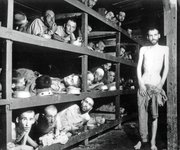
The caption tells us that Wiesel is in the picture, but we, the followers of this blog, know that he is not and that a Gigantic Fraud has been carried out concerning this picture, by powerful forces such as the New York Times, and by Wiesel himself.
Q: In your book “Night,” you describe the ardent faith you practiced as a child and address the dilemma of a compassionate God, making it clear that because of the Holocaust and what you witnessed during your ordeal, you became a skeptic. Are you still asking questions? What is the nature of your faith or nonfaith today?
A: First question, yes, I continue asking questions. I belong to the Talmud tradition. The Talmudic tradition actually emphasizes the question, much more than the answer. Answers come and go, the questions are eternal. When it comes to the question of faith, of course, … profound or painful. So what I say to myself is, “Of course I believe in God.” I believe in God because my father and my grandfather and his and so forth, they all believed, and (down) the line — I hope I’m not the last. … But my faith is a wounded faith.
Comment: Wiesel is proud to be Talmudic. In his tradition, answers are not expected. Perhaps answers are not even missed, for Talmudic Jews take pride and pleasure in endlessly discussing what is God among themselves. They determine God; it is not God who informs them. Wiesel says he continues to profess belief in God because he wants to honor his ancestors. It is a Jewish tradition.
Q: And what about the concept of justice? Is it possible to reconcile it with the abomination that was the Holocaust?
A: To me, this is the question of all questions. On many levels, I don’t understand God, which I cannot. We have a very, very great sage called Rabbi Eliezer HaKalir. He was a great, great thinker and a poet, too. And he said, “If I knew God I would be God.” So nothing concerning, really, the definitive God, the Almighty, Just, the King of the Universe is a question. I don’t know how it’s possible He knew and yet he is silent. So the silence of God troubles me. But it doesn’t stop there. The silence of the world’s leaders also troubles me.
Comment: The King of the Universe, says Wiesel, is silent about the Holocaust. Could it be because it is untrue and their God doesn’t or can’t acknowledge what is false and has no reality? In any case, Wiesel would rather focus on the world and its leadership.
Q: There’s sacred justice, but there’s also human justice.
A: Yes. Human justice. Exactly.
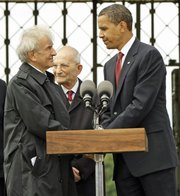
The next picture shows President Barack Obama shaking hands with Elie Wiesel, who specifically invited the U.S. president to visit the former Buchenwald camp during his trip to Germany in June 2009. Wiesel has great influence as the most famous survior of Buchenwald … but wait! He wasn’t at Buchenwald. There are no records of his being there and he is not in the famous photograph above. What kind of trick is being played on the unsuspecting President Obama?
Q. And what about that? Humans are so fallible, as we know, and their justice is imperfect. Do you still think that (human) justice could ever match the depth of the injustice of the Holocaust itself?
A: It comes to define justice. Justice with a capital J — absolute justice — is one question. But the justice which has, — how to say? — betrayed, perverted human beings, that’s another question.
Comment: This answer doesn’t answer anything. Instead, it repeats the question–a typical Wieselian response.
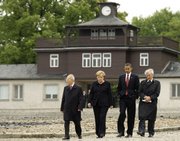
Another iconic photo chosen for this story is this one also taken at Buchenwald in 2009. It shows Obama and German Chancellor Angela Merkel walking with Wiesel (on the right), who is “showing them around.” I believe this is his very first visit there. But then, that’s no doubt true for all of them.
Q: Has life for you continued to be a long “night”? If so, what has kept you going? What, if anything, gives you joy?
A: Joy. … I see children, I have joy. I have my grandchildren, I have joy. On the other hand, I remember that we lost almost 2 million children. So the joy is not a perfect joy anymore.
Comment: Apart from the fact that 2 million children were not lost, Wiesel is a millionaire, lives in one of the highest priced locations in the world, is listened to by rulers, presidents and celebrities; has hundreds of people to do his bidding. The public treats him with reverence. His beloved State of Israel has become a great power. But I guess we’re to believe he is really suffering.
Q: Has there been any change, any little glimmer of light that managed to penetrate the “night”?
A: The answer is yes, it must be. It must. I think it was (Albert) Camus who said when there is no happiness, you must create happiness. That goes for joy, that goes for peace, that goes for all the good things in life. To say that night has vanished, no, it’s not, it’s still there. But paradoxically, other things came afterwards, and they, too, are as real. In other words, I would still say night is long and infinite, but I’m not alone in this world.
Comment: Time for the violins to start playing in the background.
Q: And in a way, perhaps, your writing itself, all the books, has helped to create some semblance of happiness for you?
A: Only if other people are happy and feel victorious over sadness. My happiness must be a result of theirs.
Comment:The violins are still playing.
Q: The Holocaust surely was an aberration, an example of Fascism run amok. But Fascism has a tendency to run amok, as you repeatedly have pointed out. You have condemned genocides and reminded the world that it must remain vigilant. How do you categorize the Holocaust? Was it unique in its nature, or only its scale?
A: No, I think it was unique; therefore, it must remain unique in memory. Once you say that it’s not, it opens history again to other mass murder. History has proven that it can and, therefore, it may continue.
Comment: Take notice! Wiesel is making it clear: the Jewish Holocaust was unique! His reasoning (?) is that if it were not, new genocides can happen. The Holocaust, by being unique, closes history to more mass murder. (This is perilously close to saying the Jews died so that others would not — an aspect of their hidden agenda to replace Christ with The Jew.) But he follows by saying it can, and may, continue. As he said at the beginning, there are no answers … not from God and not from him.
Q: You have long been a supporter of Israel, and were once invited to consider public office there.
A: (Laughing) I was offered to be a president. I was under pressure in the first few weeks, and, you know how it is, the more I said no, the harsher the pressure grew.
Comment: He has a close relationship to all top Israeli politicians, from at least 1950 on.
Q: So what made you decide to stay in the United States?
A: I came here in 1956. I came as a stateless person. Can you imagine? You cannot, because you were born here probably. … And here I came, I was accepted by the United States as an American citizen. And I had my passport all the time with me because I never had another passport in my life. So I owe this country quite a lot. I love this country.
Comment: This is an insincere answer. He could have become a citizen in any state, certainly in France even when he was underage. He didn’t want to. He wanted to be in the most powerful country, the one the Jews of Israel planned to control. This is why he came to the U.S. and devoted himself to projects like bringing into existence the United States Holocaust Memorial Museum, a huge victory for Jews.
Q: Do you ever worry about the ways in which the Holocaust has defined Jewish identity since the war?
A: Well, I know I read about it. Some people believe this is exaggerated — we shouldn’t do that. I don’t like to turn it into an object for discussion. … What every person does or thinks with regards to (an event), I don’t want to put myself in their soul-searching. I think memory is what defines a human being and society. If you betray memory, you betray yourself and all those who believe in it.
Comment: He doesn’t answer the question. In truth, the ‘Holocaust’ has defined not just Jewish, but Anglo-American and European identity in ever-increasing strength since 1945. It is non-Jews who should be very worried about how the Big H has defined our identity, which is why Wiesel avoids the subject.
Q: When it comes to Jewish identity, how important is Israel? And what do you think should be done to resolve the conflict there?
A: I’m optimistic. … My foundation has created many things. My foundation is the one that brought together the prime minister of Israel (Ehud Olmert) and (Palestinian Authority) President (Mahmoud) Abbas. (Note: The historic first meeting of Olmert and Abbas took place at the Elie Wiesel Foundation’s second annual Conference of Nobel Laureates in Petra, Jordan, on June 22, 2006.) For the first time, they met under our auspices, and they met, they fell into each other’s arms with tears in their eyes. I turned to my wife, I said, “Look.” This is the best event that I witnessed in many, many years. Which means it can be done, therefore, it will be done, my feeling is within a year or two.
Comment: How evasive is that? He brings up something that occurred in 2006 – 5 years ago! This is more avoidance of facing the real crisis that Jewish Israel has brought about by its constant theft in the name of establishing an ‘identity’ for itself.
25 Comments
Category Featured | Tags: Tags: Angela Merkel, Barack Obama, College of Charleston, Elie Wiesel, Holocaust, Jewish identity, Post and Courier, Talmud,
Social Networks: Facebook, Twitter, Google Bookmarks, del.icio.us, StumbleUpon, Digg, Reddit, Posterous.
Friday, September 23rd, 2011
By Carolyn Yeager
The real inmate at Buchenwald, Lazar Wiesel, 31 years old in 1944, was the son of Szalamo and Serena Feig Wiesel of Sighet.
We present the question of why the personal information on Lazar Wiesel is so close, but still far from exact, to that of Elie Wiesel. Can we believe, as Prof. Kenneth Waltzer would have it, that these were errors in taking down the information on Elie, and Lazar is really Elie? No, we can’t because the nature of the differences cannot be simple errors. Lazar had a brother Abram with him in the camps; the 44 year-old Abram (in 1944) cannot be turned into Elie’s father. And he certainly can’t be turned into Lazar’s father as only 13 years separated them. But it is very possible that the two families were related and that a part of Elie’s immediate family escaped the deportation altogether. Many so-called Hungarian Jews did – many more than are officially acknowledged. Keeping this in mind, I will examine the family names and see what they tell us.
Lazar Wiesel’s Buchenwald File Card (below) records Lazar’s father, Szalamo (equates to Sholomo), as being interned at Buchenwald.1 But more striking, Lazar’s mother, Serena Wiesel nee Feig, is listed on this card as being interned at KL Auschwitz. (As we know, Elie’s story is that upon arrival he saw his mother and sister moving away with the women and never saw them again. The idea they went to a gas chamber is pure speculation copied from other books.)
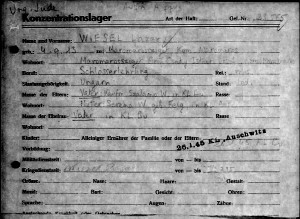
CLICK ON CARD FOR AN ENLARGED VIEW. Buchenwald Registration file card for Lazar Wiesel, birth date Sept, 4, 1913, arriving on Jan. 26, 1945 from KL Auschwitz.
Elie Wiesel’s parents are known to be Shlomo and Sara (or Sura) Wiesel, nee Feig.
In Jewish Orthodoxy (the Wiesel’s were members of the Hasidim sect) and in Eastern Europe generally, certain family names were repeatedly used—recycled if you will. This is certainly the case in the Wiesel family with the names Eliezer, Elisha, Shlomo and Sara, and probably some others we don’t know about.
It’s no surprise that we find the name of the founder of Hasidic Judaism to be Rabbi Yisroel ben Eliezer, and that he was born to Eliezer and Sara in Okopy, a small village that over the centuries has been part of Poland, Russia, and now Ukraine.
Wiesel was named after his grandfather Eliezer. His other grandfather on the maternal side is Dovid Feig.
Looking for genealogical information on Elie Wiesel is a disappointing affair—so little can be found. For such a famous person, a Nobel Peace Prize Laureate, to have his family history wiped away, hidden or not known is strange indeed. How to explain it when Hasidic family ancestry is traditionally honored and held in high esteem. It must be purposely hidden. The Jews talk about Adolf Hitler hiding his ancestry. Not at all. Hitler’s complete and accurate genealogy is available on the Internet, but Wiesel’s is not. How do we figure that?
The #1 site on Google Search for Wiesel’s genealogy is Geni which has only very limited information. There is nothing additional to be found on Wikipedia. I have filled in the gaps with two pages of testimony from Yad Vashem’s online database—one for his father that Wiesel filled out himself, and one for his father’s mother, Nisel, that was filled out by her grandson Eliezer Shlomovitz, who lives in Los Angeles, CA. This is all I could uncover and I do not guarantee the correctness of any of it.
Father: Shlomo Elisha Wiesel
- Parents: Eliezer Vizel and Nisel Vizel nee Bash. This grandfather Eliezer died serving on the side of the Austro-Hungarian Empire in WWI.
- Nisel was born in Chust (or Hust, not far from Sighet), later Ruthenian-Czechoslovakia , in 1880 to Moshe and Yehudit Bash, according to a Yad Vashem death report (mentioned above).
- Shlomo is said by several sources to have been born in 1894, but I think this is deduced from the book “Night” where he is said to have been age 50 in 1944. If this were correct, it would make Shlomo’s mother’s age 14 when he was born — highly unlikely. Elie Wiesel never gives his father’s or mother’s birth dates though it’s not like he doesn’t know.
- Wiesel writes in his memoir All Rivers Run to the Sea that he met his father’s brother Samuel in New York, but he has never written about his cousin Eliezer Shlomovitz in Los Angeles.
Mother: Sara Feig Wiesel
- Parents: Dodye (Dovid) Feig; no mother given
- Wiesel highly praises this grandfather in All Rivers and writes, “… in 1944 my parents invited him and his wife to live with us.” His wife, not ‘my grandmother.’ That is the only mention of ‘her.’ Seems clear she was not Elie’s grandmother, but a new wife. In any case, grandfather Feig declined and went to stay with his sons.
- Elie writes in All Rivers: “I had four uncles on my mother’s side: Chaim-Mordechai, Ezra, Israel and Moshe-Itzik
- He met an ‘Uncle’ Morris in New York.
From the little we have available, we can see certain names repeating. Elie Wiesel gave his son his father’s name, Shlomo Elisha. He himself was named after his paternal grandfather Eliezer. A cousin, another grandson of his paternal grandmother, is also named Eliezer. This cousin’s last name is Shlomovitz. From this we can begin to ascertain that Eliezer, Shlomo, Elisha and Sara are “family names” within the extended Wiesel family, along with being Hasidic names.
Two marriages between the Wiesel’s and the Feig’s
Looking back at the Lazar (from Eliezer) Wiesel who was at Buchenwald, we see another marriage between the Wiesel’s and the Feig’s. We see the same names: father is Szalamo (Shlomo); mother is Serena Feig. Lazar is 15 years older than Elie and his brother Abram is 28 years older, and they are from the same city, Sighet. It seems pretty clear to me that these are two branches of the family tree.
Matchmaker, Matchmaker, make me a match!
 Orthodox men and women usually meet through matchmakers in a process called a shidduch. A matchmaker’s services are necessary because of the constant intermarriage going on within the closely knit Orthodox communities. A matchmaker (shadchan) knew of the relations between those in the community, or could find them out, and could therefore prevent or warn against marriages between a couple who were too genetically similar. This role is not mentioned on Wikipedia and other Jewish sites, but it’s the most important one. In Night, Wiesel wrote that in 1943 his mother “was beginning to think it was high time to find an appropriate match for Hilda” who was already 21 years of age.2
Orthodox men and women usually meet through matchmakers in a process called a shidduch. A matchmaker’s services are necessary because of the constant intermarriage going on within the closely knit Orthodox communities. A matchmaker (shadchan) knew of the relations between those in the community, or could find them out, and could therefore prevent or warn against marriages between a couple who were too genetically similar. This role is not mentioned on Wikipedia and other Jewish sites, but it’s the most important one. In Night, Wiesel wrote that in 1943 his mother “was beginning to think it was high time to find an appropriate match for Hilda” who was already 21 years of age.2
The two families, Feig and Wiesel, may have been recognized as having diverse enough genetic relationship to one another to make for viable marriages. Perhaps there was a history of successful unions between the two family lines. In any case, it can explain the similarity in personal information between the older and younger Wiesel, and also the temptation to claim the one to be the other. The family members can be trusted to remain silent about it.
This last part is speculation, but one thing we notice is that Elie Wiesel does not want us to know who or where are the members of his family, and even more, he doesn’t want any of his family members to talk to us, the general public. We are not to know anything but the simplistic legend that he and his supporters and defenders have created for our consumption.
An interesting side-note: I just discovered a book From Generation to Generation by Arthur Kurzweil, published in 2004, which features on the cover “Foreword by Elie Wiesel.” This foreword turns out to be only one page long, much shorter than the Acknowledgements even, and consists of a few vague words about the mystical aspect of names. What is interesting is that the book is 400 pages of “how to research your Jewish genealogy.” If Wiesel has researched his own, he certainly is not publishing it. Wiesel gives himself the prerogative of remaining a very private man, while working hard to become a highly public name. Jewish chutzpah at work.~
Endnotes:
1. Myklos Gruener never mentioned a father for Lazar and Abram, only his own father.
2. Elie Wiesel, Night, Hill and Wang, 2006 (original copyright 1958), p. 8
1 Comment
Category Featured | Tags: Tags: Abram Wiesel, Buchenwald, Elie Wiesel, Lazar Wiesel, matchmakers, Sara and Serena Wiesel nee Feig, Shlomo Wiesel,
Social Networks: Facebook, Twitter, Google Bookmarks, del.icio.us, StumbleUpon, Digg, Reddit, Posterous.
Monday, September 12th, 2011
By Carolyn Yeager
Proof that the man in the famous Buchenwald photograph is NOT Elie Wiesel.
With the help of the New York Times and the U.S. Holocaust Memorial Museum, Elie Wiesel and his backers did not shy away from criminal deceit by purposely misidentifying an unknown face in this famous photo as belonging to Elie Wiesel.
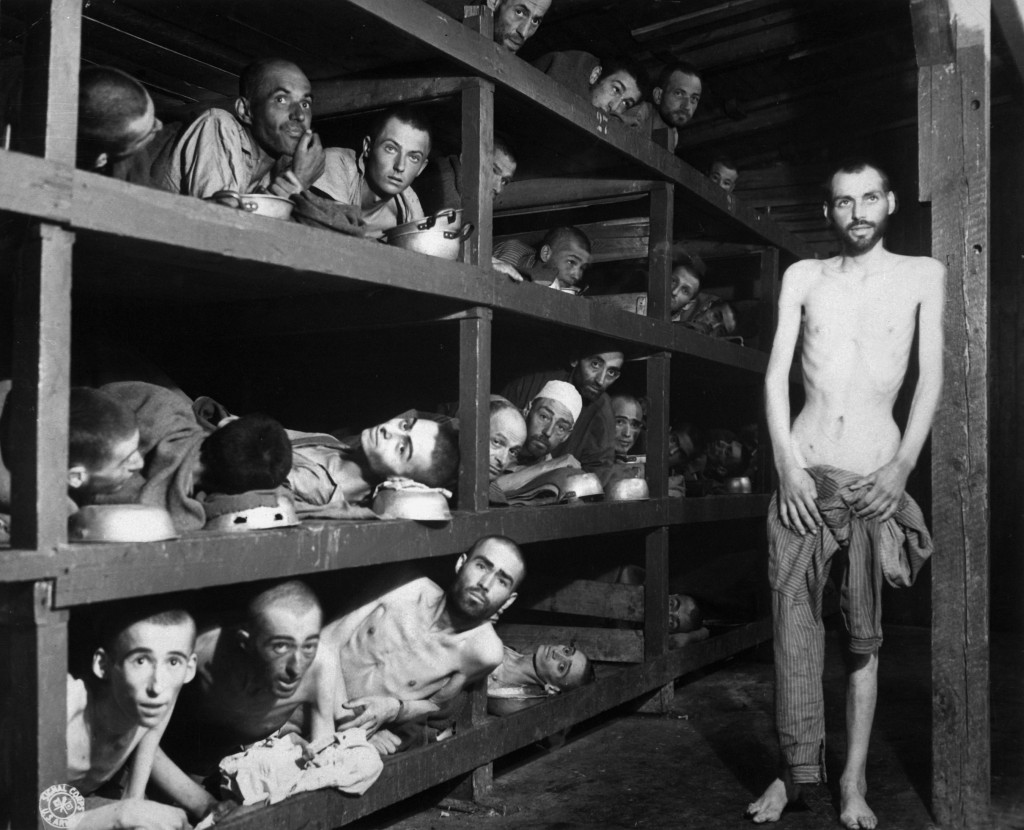
The above high-resolution photograph of Buchenwald survivors was first published in the New York Times on May 6, 1945 with the caption “Crowded Bunks in the Prison Camp at Buchenwald”. [click on image twice to enlarge fully] It was taken inside Block #56 by Private H. Miller of the Civil Affairs Branch of the U.S. Army Signal Corps on April 16, 1945, five days after the Buchenwald camp was liberated by a division of the US Third Army on April 11, 1945. None of the men in the picture were identified at that time.
The U.S. Army photographer was in block #56, not #66
The U.S. Army photographer said he was inside Block #56. The “children’s block” that housed the so-called “boys of Buchenwald” was #66. This was not a typo. Note that these men are not children or teenagers, except for the youngster on the lower left who has been correctly identified as 16 yr. old Myklos (Nikolaus) Grüner, and maybe a couple others. These adults appear to be a mixture of sick individuals suffering from a wasting disease (Grüner learned after liberation he had TB), along with basically healthy men who were also in that block, for some unknown reason, five days after they had been freed. As we have read from many Buchenwald inmates, they moved about at will from the day of liberation onward. In Elie Wiesel’s book Night, he even says that some of the boys in his block went to the city of Weimar the very next day to steal potatoes and rape girls.
The true facts of this photograph have never been told and perhaps are not known. (Grüner has written in Stolen Identity that he left a procession of youths being led to the camp entrance on the morning of April 11, scurried into the nearest barracks and jumped into an empty bunk space. It turned out to be this one.) But because of the man standing there stark naked except for a piece of clothing held in his hands to cover himself, this photograph was certainly staged. In any event, it was never represented as the “children’s barracks.” Still, Elie Wiesel inexplicably once told an interviewer for the German weekly Die Zeit that this photograph was taken in the Children’s Block and all these men were really teenagers even though they looked old. (Source: “1945 und Heute: Holocaust,” Die Zeit, April 21, 1995.)
Kenneth Waltzer wrote to this website EWCTW on Nov. 14, 2010: “Eli Wiesel was indeed the Lazar Wiesel who was admitted to Buchenwald on January 26, 1945, who was subsequently shifted to block 66…” and Waltzer repeated in another comment on June 27, 2011 that “— after his father died — Elie Wiesel was moved in early February to block 66, the kinderblock. Miklos Gruner too was in block 66. Elie Wiesel was there with other boys from Sighet, who knew him.”
But we are also to accept that on April 16 Wiesel was in block 56, even though he didn’t report any such move in his book Night. In fact, in that fictitious story, Wiesel says he became deathly ill with food poisoning three days after liberation (April 14) and spent the next two weeks in hospital (pg 115, Marion Wiesel translation). That in itself precludes his being in this photograph taken on April 16!
Whom do you believe—the New York Times or your own eyes?
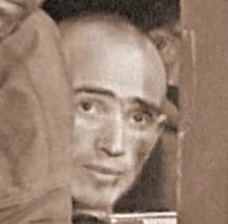
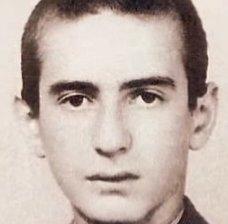 Not Wiesel at age 16 in 1945
Not Wiesel at age 16 in 1945
You can see for yourself from these two high-quality photographs supplied to me by a helpful reader that the face on the left is not Wiesel. A close inspection of the prisoners in the bunks in the famous photograph reveals that the eyebrows on many (including the one on the left above) were emphasized with a dark crayon/pencil … in other words, retouched or “photo-shopped.” On the right is what is claimed to be Elie Wiesel in 1944 at the age of 15.
The inmate on the left definitely has an aquiline nose and full, even sensual, lips. In this close-up, the receding hairline is visible on the recently shaved head. On the right, the real 15-year-old Elie Wiesel exhibits a normal youthful hairline, a bigger and longer nose and thinner lips. He also has a higher forehead and longer face than the more roundish-headed inmate. The eyes of the man on the left are not as deep-set under the eyebrows. His somewhat surprised, curious expression is not typical of Wiesel, whose expression was generally reserved, and often hooded.
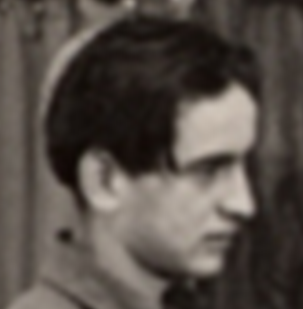
The close-up on the left appears to be the real Elie Wiesel in France later in 1945. He would be 17 or almost 17 years old in this picture. Notice the non-receding, youthful hairline with a very long front lock hanging to the side, and the straight nose .
This close-up image is from the photograph below, which is found at the USHMM Survivor Resource Center with the caption given below. (click here or on lower pic for an undistorted, larger image)
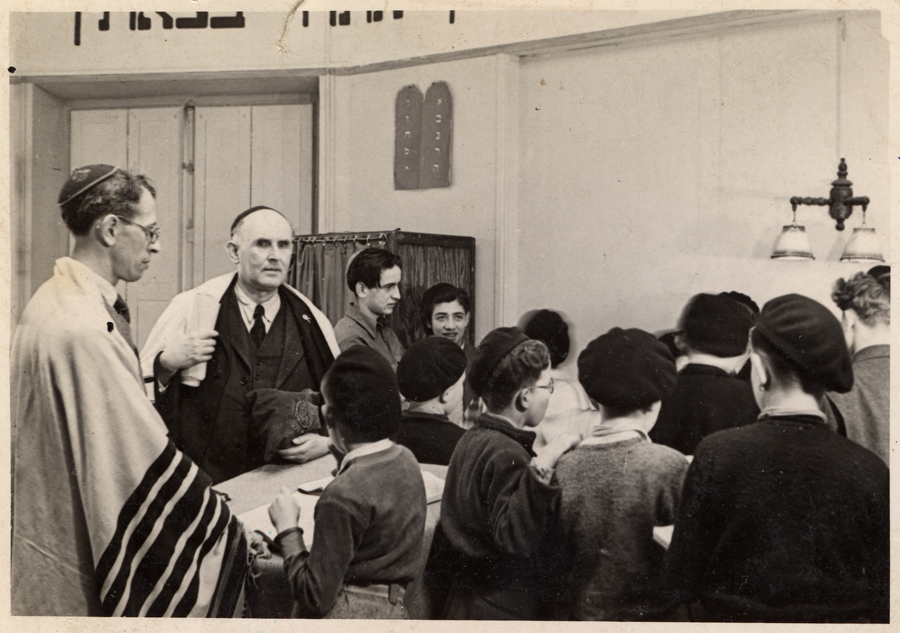
Above, Jewish boys gather for a prayer service in a chapel in an OSE children’s home in 1945. Those pictured include Elie Wiesel (seen in profile) and Jakob Rybsztajn standing next to him facing the camera. (I note that Elie Wiesel is older than the other boys in this picture, giving support to the idea that he acted in the role of counselor and sometime teacher to the newer, younger religious boys.)
Notice again the straight nose, the high forehead, deep-set eyes, large ears, sensitive mouth and slender neck. But also look at all that hair! The date of this picture is given by USHMM as 1945 and the location as Ambloy, [Loir et Cher] France. It says in the accompanying text “In October 1945 the children and staff of Ambloy were relocated to the Chateau de Vaucelles in Taverny (Val d’Oise).” That means this picture was taken between June and October 1945. They could have been celebrating Rosh Hashana, Yom Kippur or Sukkot.
But could his hair have grown to such a length from a shaved head in April 1945? No way, and thus we have another proof that the liberated Buchenwald inmate with the shaved head is NOT Elie Wiesel.
A PDF from my valued contributer examines the ages of the small group more closely. In my opinion, he has the ages of all four men a little too young but especially #2 and 4. Take a look: four men in bunk
Who first identified Elie Wiesel in the famous Buchenwald liberation photo?
In October 1983 the Jewish-owned New York Times published this photograph as part of an article in its high circulation Sunday NYT Magazine with the caption: “On April 11, 1945, American troops liberated the concentration camp’s survivors, including Elie, who later identified himself as the man circled in the photo.”
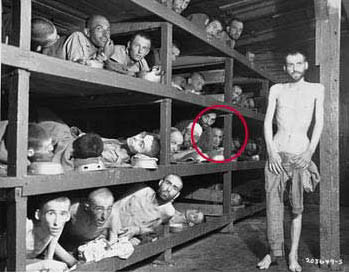
It was also in 1983 that Wiesel’s friend Sigmund Strochlitz began campaigning for a Nobel prize for Wiesel. Letters of nomination are due into the Nobel committee by Feb.1 of each year, so by January 1984, the committee was receiving letters nominating Wiesel from U.S. Senators such as Daniel Moynihan and Barry Goldwater (both Jewish). [see “How Elie Wiesel Got the Nobel Peace Prize“] The effort continued, with new and ever more innovative ideas, through 1985 and 1986 with the help of Jew John Silber, President of Boston University, Wiesel’s employer. Hundreds were enlisted into the effort.
The 1983 article in the New York Times that was the opening gun of the campaign was written by Jew Samuel Freedman and titled “Bearing Witness: The Life and Work of Elie Wiesel.” It included this line: “His name has been frequently mentioned as a possible recipient of a Nobel Prize, for either peace or literature.” Well, it had just begun to be mentioned … by this team of cheerleaders.
Wiesel pretends that he had nothing to do with it. In an interview in France in 2009, he said: “If you fight or if you do scientific research to get the Nobel, you never succeed and you should not succeed.” (Elie Wiesel, “messager de la memoire”) No, he did not fight but his mercenaries fought for him, and he used this photograph as his “research.” That this photograph played a large role is shown by the fact that immediately after the Nobel award ceremony in December 1986, Wiesel went to Yad Vashem Memorial in Jerusalem and posed in front of its prominent display there.
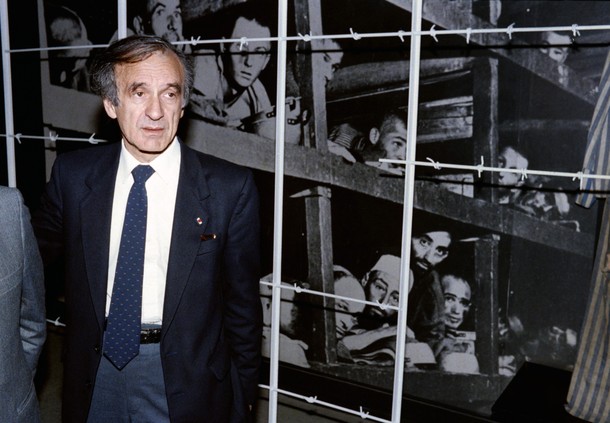
Elie Wiesel on Dec. 18, 1986 at Yad Vashem in Jerusalem
After the award was announced by the Nobel Committee, the New York Times published on Nov. 1 a severely cropped version of the Buchenwald photo (below) with the caption: “Elie Wiesel, the winner of the Nobel Peace Prize (at far right in the top bunk) in the Buchenwald concentration camp in April 1945, when the camp was liberated by American troops.” The picture accompanied an article by Jew Martin Susskind titled, “A Voice from Bonn: History Cannot Be Shrugged Off.”
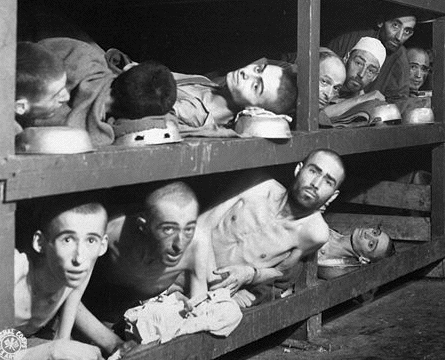
The role played by the tax-payer funded United States Holocaust Memorial Museum
Elie Wiesel finagled his way to becoming Founding Chairman of the United States Holocaust Memorial Council in 1980 after being chosen in 1978 by President Jimmy Carter as chairman of the President’s Commission on the Holocaust. Why the United States needed to do anything at all about the “Holocaust” is something only the 2.5% Jewish population in this country can answer. It is to satisfy them. Wiesel continued to chair the Council until 1986, when he reached his goal of becoming a Nobel Laureate. The USHMM was undoubtedly an important institutional heavyweight that leveraged him to the Nobel.
The USHMM naturally accepted that Wiesel was in the famous photograph as soon as he and the New York Times said he was. If you think the museum staff does real research, is searching for truth and/or is engaged in scholarship of any kind, you are badly mistaken. The museum represents official power only and is invested in keeping it in Jewish hands.
This photograph is the only document tying Elie Wiesel to the Holocaust
The only document that connects Elie Wiesel to the Auschwitz-Birkenau and Buchenwald experience he claims to have—in other words, his claim to be an authentic “Holocaust survivor”—is the famous Buchenwald liberation photograph. There are no records with his name and birth date for either camp. His books do not support his presence there very well. That’s why the Wiesel promoters, who wanted to anchor their man’s claim to be the unchallenged spokesman for the world’s greatest victims—which winning a Nobel prize would surely do—decided that they could pawn that unknown face off as the face of Wiesel. This decision was made in 1983. It’s certain that Elie Wiesel took part in making it, though the pretense is kept up by all that he was aloof from the entire process.
What you must do
When you comprehend the immense power that this simple photo comparison and commentary gives us, you know that we have it in our hands to break down the Wiesel legend if this knowledge is widely circulated. If you understand this, you know what you must do. You must post this article everywhere you can, you must tell everyone about it, send it to all you know … make sure that this photo comparison moves through the Internet and finds a home in as many places as possible. And keep it up, because once is not enough. I’ve done my part, readers. Now it’s up to you.
54 Comments
Category Featured | Tags: Tags: Ambloy France, Block 66, boys of Buchenwald, Buchenwald liberation, Elie Wiesel, Holocaust fraud, Ken Waltzer, Myklos Gruener, New York Times, Nobel Peace Prize, OSE, US Holocaust Memorial Museum, USHMM,
Social Networks: Facebook, Twitter, Google Bookmarks, del.icio.us, StumbleUpon, Digg, Reddit, Posterous.
Tuesday, September 6th, 2011
Edited on Sept. 8, 2011, 4:30 p.m.
By Carolyn Yeager
Another official transport list of the youths sent to France from Buchenwald in summer 1945 has come to my attention. Can it possibly be the “smoking gun” to prove that Elie Wiesel in not one of the “boys of Buchenwald?”
On June 14, I posted a blog on this site questioning “What Happened to Waltzer’s Book about the ‘boys of Buchenwald?’” Professor Ken Waltzer of Michigan State University wrote a comment to that blog in which he stated, “Elie Wiesel was there (in Block 66 at Buchenwald) with other boys from Sighet, who knew him; he was interviewed by military authorities after liberation, in order to permit departure from the camp; and he went after liberation in early June, 1945, to France, to Ecouis…. one among 425 boys who did so.”
Prof. Waltzer has for years been firm in his insistence that Elie Wiesel was on the transport to France from Buchenwald, as one of the “boys of Buchenwald,” a legend in the making. This is largely based on a document containing the name of Lazar Wiesel of Sighet, born Oct. 4, 1928, on the transport list of over 500 Jewish “orphans” from Buchenwald to Paris dated 16th July, 1945. (Note: Elie Wiesel’s official birth date is Sept. 30, 1928)
Page 9 of this list, as well as the cover page, as received by Myklos (Michael) Grüner from the Buchenwald Gedenkstätten (Archival Records Office) is viewable on Elie Wiesel Cons The World under “The Evidence” on our menu bar (click on “The Documents” and then the link at #14). You will notice on that page that number 405 is WIESEL, Lazar.
HOWEVER … it has come to my attention from a helpful, dear reader that at the website of the American Jewish Joint Distribution Committee (http://www.jdc.org) (AJJDC) we find the same list only now it is titled “Orphan Children from Buchenwald now in Paris” –Convoy of 8th June, 1945.”
Here we see number 405 listed as WIEZEN instead of WIESEL. To get two letters in a single surname wrong seems unlikely, especially when it’s connected to a birth date that is not Elie Wiesel’s.
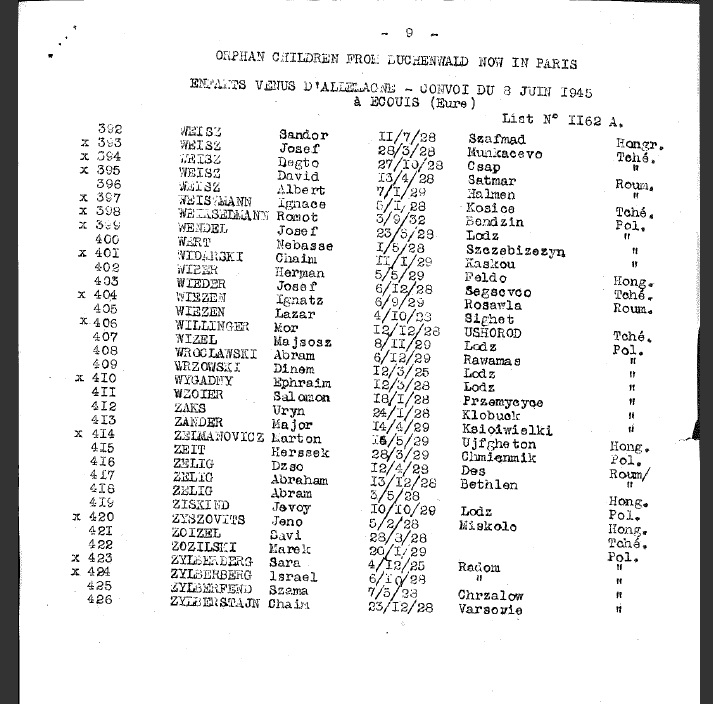
Wiezen or Wiesel?
That the documents are not the same is borne out by the fact that the AJJDC page 9 document above begins with #392 WEISZ, Sandor, while the Buchenwald/Grüner page 9 document begins with #398 WECHSZLMAN, Remet. In addition, there are other differences on this page in name spellings and two in birth dates.
The nature of these differences suggest to me that they may be corrections made in France to the mainly minor mistakes on the list from Buchenwald. This idea is bolstered by the probability that the AJJDC and the Jewish personnel at Ecouis had more interest in and time to spend in learning about each youth’s personal information than did the American Military personnel at Buchenwald, plus they would be more familiar with Jewish/Yiddish names and they would be more concerned with accuracy. There is good reason, when you closely compare the two documents, to speculate that the latter document was typed up in France (AJJDC version shown above) and is the more correct one.
We also have to consider how unlikely it is that the AJJDC would want to tamper with the list to change WIESEL to WIESEN, thus denying that a Wiesel was transported to France from Buchenwald. If any tampering were done, it would more likely be at the other end, at Buchenwald. But I am not charging that … yet.
Confusion over Lazar Wiesel
That said, let’s consider some other aspects. In light of the utter confusion of records for Lazar Wiesel, who arrived at Buchenwald from Auschwitz on Jan. 26, 1945 with a birth date of Sept. 4, 1913 and was given ID number 123565, but who then either got lost or was “reassigned” ID number 123165, which had belonged to Pavel Kuhn, a Slovenian Jew who arrived on the same transport from Auschwitz in January and died on March 8. (See The Documents, # 11, fig. 12.1) The name belonging to this ID number was then given as Lázár Wiesel (with accented “a’s”) who signed the Military Government questionnaire on April 22, giving his birthdate as Oct. 4, 1928 (See The Documents, #11). This is said to be the 16-year-old Lazar Wiesel coming from Buchenwald to France and arriving in Paris on June 8.
This is not at all clear! But now add to it that this person was named Wiesel when he left Buchenwald, but Wiezen after he arrived The rest of his information remains the same. Note also that the signature of “Lázár Wiesel” on the Questionaire is totally different from the signature of Elie Wiesel that is well-known. In addition, the only photograph that claims to be of Wiesel at Buchenwald is provably not Wiesel.
Everything points to an answer that Elie Wiesel was not the one who was at Buchenwald and who traveled to France in summer 1945. As I suggested in a following blog “New Photo of ElieWiesel in France?” he could have arrived in France sometime during the war—helped by the Jewish network and placed in the children’s welfare institutions there.
The ubiquity of the names Lazar and Shlomo Wiesel
I wrote briefly in The Shadowy Origins of Night, Part II that Sighet, Elie Wiesel’s birthplace, had a large Jewish population and that I had counted 19 Eliezer or Lazar Wiesel’s or Visel’s from the small Maramures District of Romania listed as Shoah victims on the Yad Vashem Central Database. Nineteen who died in the “Holocaust”! Just think how many survived and continued to carry and pass on this name. Some were no doubt relatives of Elie’s family. The same is true for Shlomo Wiesel/Vizel—there are many of them in the Yad Vashem database also.
The lesson of this, of course, is that simply seeing the name “Lazar Wiesel” doesn’t mean it is the one and only Elie Wiesel. That different birth dates are given for “Lazar Wiesel” fits this reality perfectly. It’s also true that Elie went by the name of Eliezer, his grandfather’s name, a distinction not without meaning. This will come up again, when I write about Wiesel’s family.~
30 Comments
Category Featured | Tags: Tags: AJJDC, boys of Buchenwald, Ecouis, Elie Wiesel, Ken Waltzer, Orphan convoy,
Social Networks: Facebook, Twitter, Google Bookmarks, del.icio.us, StumbleUpon, Digg, Reddit, Posterous.















